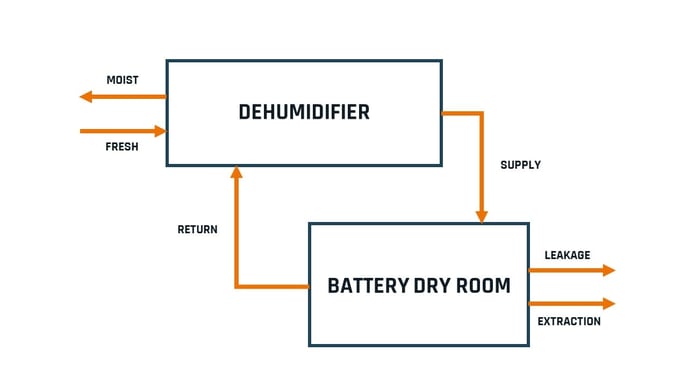WHAT IS A BATTERY DRY ROOM?
A battery dry room is a specialized environment where the moisture content of the air is meticulously controlled to ensure the safe and high-quality manufacturing of products, particularly lithium-ion (Li-ion) batteries. This controlled environment is crucial in the production of Li-ion batteries to prevent moisture-related issues that can impact safety, quality, and overall manufacturing efficiency.
Manufacturing Li-ion batteries for electric vehicles is a complex and extremely sensitive process, as lithium is extremely sensitive to moisture in the air, easily absorbing it. This means that the slightest exposure to moisture leads to reduced performance and the product life of Li-ion batteries. A low dewpoint means less humidity in the air. Therefore, reliable and efficient dehumidification solutions to prevent lithium from absorbing moisture from the air are crucial.
HERE'S WHY THE AIR INSIDE A BATTERY DRY ROOM NEEDS TO HAVE EXTREMELY LOW DEW POINTS:
Moisture Sensitivity
Batteries, especially lithium-ion batteries, are highly sensitive to moisture. Exposure to moisture can lead to chemical reactions, corrosion, and a reduction in battery performance and lifespan. Therefore, maintaining a dry environment is crucial to ensuring the quality and reliability of the batteries being manufactured.
Electrochemical Reactions
Moisture can catalyse undesirable chemical reactions within batteries, leading to the degradation of electrode materials, electrolytes, and other critical components. This can result in reduced energy storage capacity and overall battery performance.
Safety Concerns
In some cases, moisture-induced chemical reactions within batteries can lead to safety hazards, including the risk of thermal runaway or fire. Keeping moisture levels low helps mitigate these risks.
Consistency and Quality Control
In industries like electronics and pharmaceuticals, where precise manufacturing processes are essential, maintaining a consistent and dry environment is critical to ensuring product quality and reliability.
HOW ARE EXTREMELY LOW DEW POINTS ACHIEVED IN BATTERY DRY ROOMS?
Achieving extremely low dew points in battery dry rooms involves a combination of specialised construction and dedicated equipment.

Purpose-Built Construction:
- The dry room, the air handling unit, and all connecting equipment are constructed with precision and purpose.
- A crucial aspect is ensuring the dry room is exceptionally airtight, preventing any air leakage that could compromise the controlled environment.
Limited Air Extraction:
- To conserve valuable dry air, air extraction is minimised as much as possible.
- This limitation of air extraction helps maintain a positive pressure within the room, preventing the escape of highly valuable dry air from the system.
Welded Ductwork:
- Welded ductwork is preferred to eliminate any potential leakage of air.
- This choice of ductwork further enhances the room's airtightness and contributes to maintaining the desired low humidity levels.
Carefully Selected Filters and Flowrates:
- Filters and flowrates are carefully chosen to meet clean room requirements while minimising unnecessary energy consumption.
- These selections ensure that the system operates efficiently, providing the necessary dehumidification without wasteful energy usage.
Specialised Dehumidification Equipment:
- Battery dry rooms rely on specialised equipment such as dehumidifiers and desiccants.
- These systems are designed to remove moisture from the air effectively, reducing humidity to levels where the dew point is well below the operating conditions of the room.
Ensuring Moisture Control:
- The ultimate goal is to create an environment where moisture levels are meticulously controlled.
- By maintaining low humidity and achieving a low dew point, even if the room's temperature were to drop, moisture would not condense on surfaces or within the materials being processed or stored in the dry room.
The combination of construction techniques and specialised equipment ensures that battery dry rooms can consistently achieve and maintain the extremely low dew points necessary to protect sensitive processes and materials in industries like battery manufacturing and electronics production.
WHAT ARE THE TYPICAL HUMIDITY AND TEMPERATURE LEVELS IN BATTERY DRY ROOMS?
In battery dry rooms, temperature and humidity levels are meticulously controlled to ensure the integrity of the manufacturing process. During the cell assembly process step, a temperature of 22°C +/-2°C is typically required.
Dew points vary depending on the specific process step, ranging from -40°C to -70°C or even lower, depending on the sensitivity of the materials and processes involved.
Humidity levels are maintained at extremely low levels, often below 1% relative humidity.
WHAT ARE THE ENERGY DEMANDS ASSOCIATED WITH A BATTERY DRY ROOM?
Battery dry rooms demand significant energy due to the need for temperature control and dehumidification. The large volume of air that requires conditioning adds to the energy demand. Therefore, efficient dehumidification solutions are crucial to prevent lithium-ion batteries from absorbing moisture and to optimise energy usage in the dry room.
In summary, a battery dry room is essential in industries where moisture sensitivity is a concern, and it's critical for ensuring the quality, performance, and safety of products like batteries and electronic components. Extremely low dew points are necessary to prevent moisture-related issues and maintain the desired environmental conditions within the room.
CHECKLIST
The following considerations are Important for keeping battery dry room consumption low:
Dehumidifier:
- Choose a high-efficiency dehumidifier (DHU) Link to 1, 2 or 3 dehumidification stages
- Run the DHU on waste heat, heat pumps or other sources of cheap and sustainable energy. See saving potential here.
Battery Dry Room:
- Reduce leakages
- Well-sealed or welded ducting
- Well-sealed dry rooms
- Keep extraction low
- Efficient filtering of dust
- Challenge suppliers of equipment on needed extraction
- Isolate solvents to a few places
